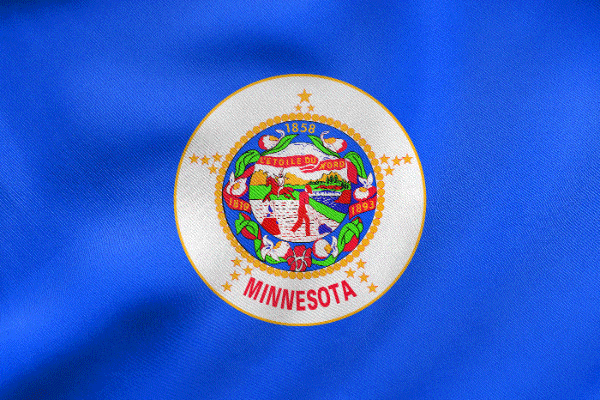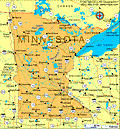

Capital: St. Paul
State abbreviation/Postal code: Minn./MN
U.S. Representatives: 8
Organized as territory: March 3, 1849
Entered Union (rank): May 11, 1858 (32)
Present constitution adopted: 1858
Motto: L'Étoile du Nord (The North Star)
State symbols:
flower lady slipper (1902)
tree red (or Norway) pine (1953)
bird common loon (also called great northern diver) (1961)
song “Hail Minnesota†(1945)
fish walleye (1965)
mushroom morel (1984)
Nicknames: North Star State; Gopher State; Land of 10,000 Lakes
Origin of name: From a Dakota Indian word meaning “sky-tinted waterâ€
10 largest cities (2012): Minneapolis, 392,880; St. Paul, 290,770; Rochester, 108,992; Duluth, 86,211; Bloomington, 86,033 Brooklyn Park, 77,752; Plymouth, 72,928; St. Cloud, 65,986; Eagan, 64,854; Woodbury, 64,496
Land area: 79,610 sq mi. (206,190 sq km)
Geographic center: In Crow Wing Co., 10 mi. SW of Brainerd
Number of counties: 87
Largest county by population and area: Hennepin, 1,152,425 (2010); St. Louis, 6,226 sq mi.
State forests: 58 (nearly 4 million ac.)
State parks: 72
Residents: Minnesotan
2015 resident population est: 5,489,594
Following the visits of several French explorers, fur traders, and missionaries, including Jacques Marquette, Louis Joliet, and Robert Cavelier, Sieur de la Salle, the region was claimed for Louis XIV by Daniel Greysolon, Sieur Duluth, in 1679.
The U.S. acquired eastern Minnesota from Great Britain after the Revolutionary War and 20 years later bought the western part from France in the Louisiana Purchase of 1803. Much of the region was explored by U.S. Army lieutenant Zebulon M. Pike before the northern strip of Minnesota bordering Canada was ceded by Britain in 1818.
The state is rich in natural resources. A few square miles of land in the north in the Mesabi, Cuyuna, and Vermilion ranges produce more than 75% of the nation's iron ore. The state's farms rank high in yields of corn, wheat, rye, alfalfa, and sugar beets. Other leading farm products include butter, eggs, milk, potatoes, green peas, barley, soybeans, oats, and livestock.
Minnesota's factories produce nonelectrical machinery, fabricated metals, flour-mill products, plastics, electronic computers, scientific instruments, and processed foods. The state is also a leader in the printing and paper-products industries.
Minneapolis is the trade center of the Midwest, and the headquarters of the world's largest super-computer and grain distributor. St. Paul is the nation's biggest publisher of calendars and law books. These “twin cities†are the nation's third-largest trucking center. Duluth has the nation's largest inland harbor and now handles a significant amount of foreign trade. Rochester is home to the Mayo Clinic, a world-famous medical center.
Tourism is a major revenue producer in Minnesota, with arts, fishing, hunting, water sports, and winter sports bringing in millions of visitors each year.
Among the most popular attractions are the St. Paul Winter Carnival; the Tyrone Guthrie Theatre, the Institute of Arts, Walker Art Center, and Minnehaha Park, in Minneapolis; Boundary Waters Canoe Area; Voyageurs National Park; North Shore Drive; the Minnesota Zoological Gardens; and the state's more than 10,000 lakes.

No comments:
Post a Comment